DODGE RAM 2003 Service Repair Manual
Manufacturer: DODGE, Model Year: 2003, Model line: RAM, Model: DODGE RAM 2003Pages: 2895, PDF Size: 83.15 MB
Page 1881 of 2895
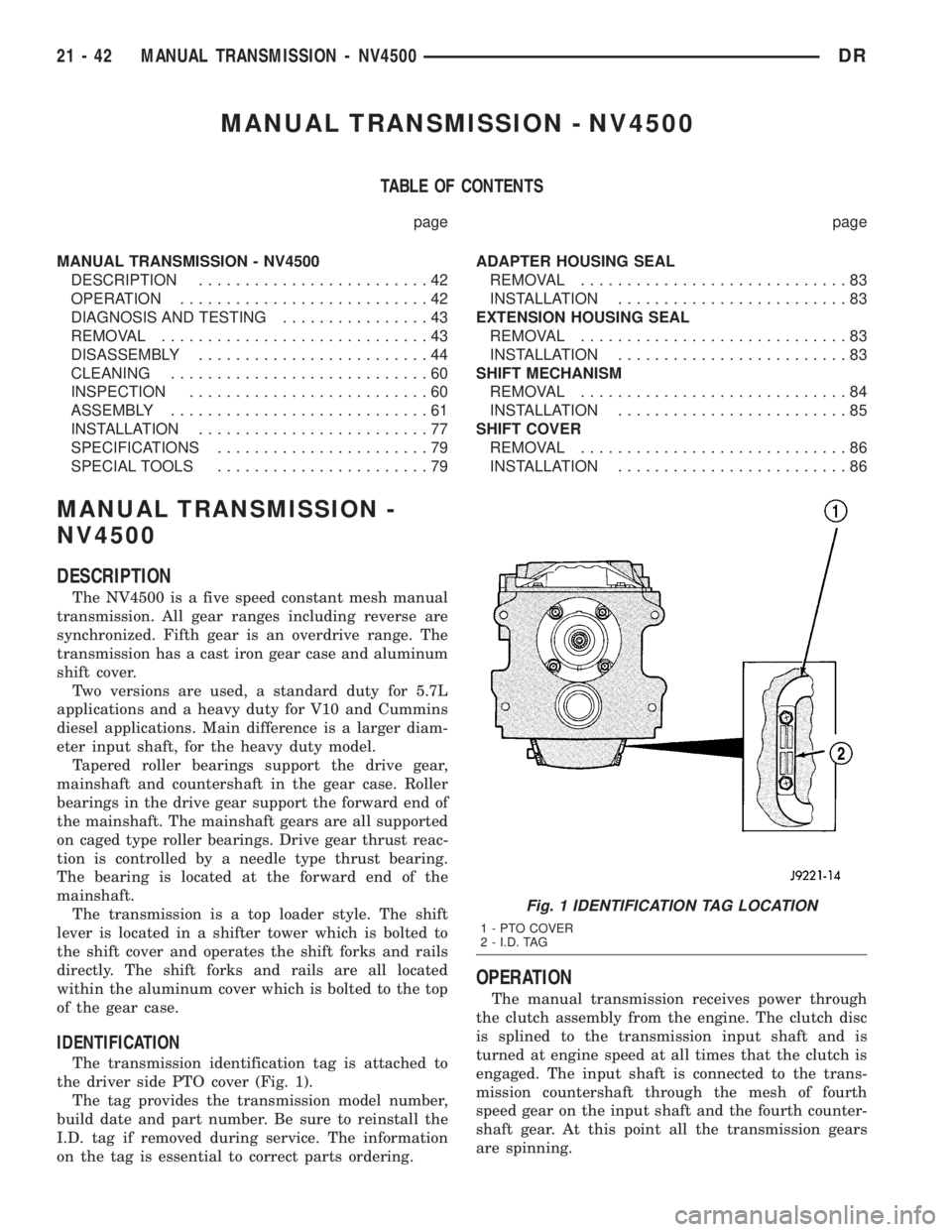
MANUAL TRANSMISSION - NV4500
TABLE OF CONTENTS
page page
MANUAL TRANSMISSION - NV4500
DESCRIPTION.........................42
OPERATION...........................42
DIAGNOSIS AND TESTING................43
REMOVAL.............................43
DISASSEMBLY.........................44
CLEANING............................60
INSPECTION..........................60
ASSEMBLY............................61
INSTALLATION.........................77
SPECIFICATIONS.......................79
SPECIAL TOOLS.......................79ADAPTER HOUSING SEAL
REMOVAL.............................83
INSTALLATION.........................83
EXTENSION HOUSING SEAL
REMOVAL.............................83
INSTALLATION.........................83
SHIFT MECHANISM
REMOVAL.............................84
INSTALLATION.........................85
SHIFT COVER
REMOVAL.............................86
INSTALLATION.........................86
MANUAL TRANSMISSION -
NV4500
DESCRIPTION
The NV4500 is a five speed constant mesh manual
transmission. All gear ranges including reverse are
synchronized. Fifth gear is an overdrive range. The
transmission has a cast iron gear case and aluminum
shift cover.
Two versions are used, a standard duty for 5.7L
applications and a heavy duty for V10 and Cummins
diesel applications. Main difference is a larger diam-
eter input shaft, for the heavy duty model.
Tapered roller bearings support the drive gear,
mainshaft and countershaft in the gear case. Roller
bearings in the drive gear support the forward end of
the mainshaft. The mainshaft gears are all supported
on caged type roller bearings. Drive gear thrust reac-
tion is controlled by a needle type thrust bearing.
The bearing is located at the forward end of the
mainshaft.
The transmission is a top loader style. The shift
lever is located in a shifter tower which is bolted to
the shift cover and operates the shift forks and rails
directly. The shift forks and rails are all located
within the aluminum cover which is bolted to the top
of the gear case.
IDENTIFICATION
The transmission identification tag is attached to
the driver side PTO cover (Fig. 1).
The tag provides the transmission model number,
build date and part number. Be sure to reinstall the
I.D. tag if removed during service. The information
on the tag is essential to correct parts ordering.
OPERATION
The manual transmission receives power through
the clutch assembly from the engine. The clutch disc
is splined to the transmission input shaft and is
turned at engine speed at all times that the clutch is
engaged. The input shaft is connected to the trans-
mission countershaft through the mesh of fourth
speed gear on the input shaft and the fourth counter-
shaft gear. At this point all the transmission gears
are spinning.
Fig. 1 IDENTIFICATION TAG LOCATION
1 - PTO COVER
2 - I.D. TAG
21 - 42 MANUAL TRANSMISSION - NV4500DR
Page 1882 of 2895
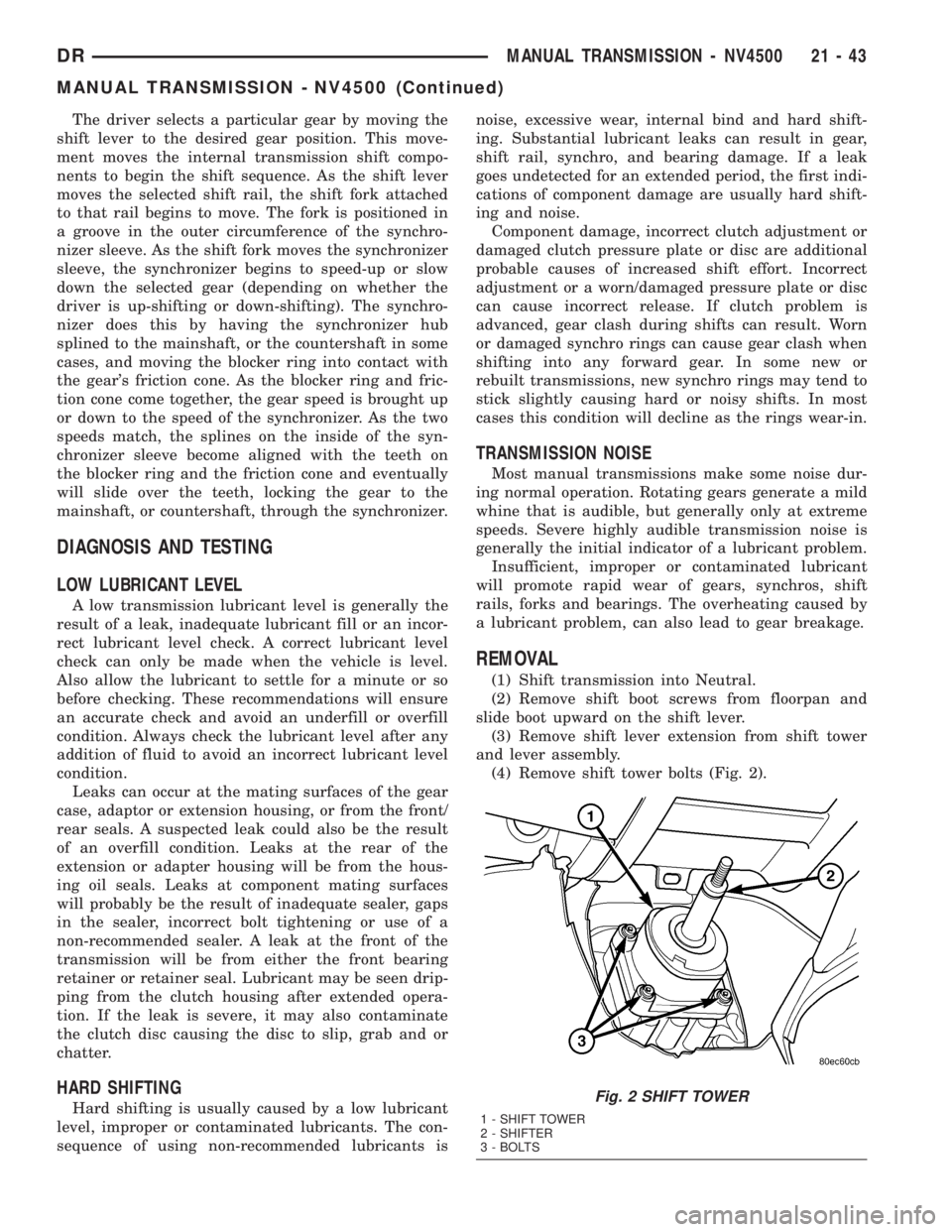
The driver selects a particular gear by moving the
shift lever to the desired gear position. This move-
ment moves the internal transmission shift compo-
nents to begin the shift sequence. As the shift lever
moves the selected shift rail, the shift fork attached
to that rail begins to move. The fork is positioned in
a groove in the outer circumference of the synchro-
nizer sleeve. As the shift fork moves the synchronizer
sleeve, the synchronizer begins to speed-up or slow
down the selected gear (depending on whether the
driver is up-shifting or down-shifting). The synchro-
nizer does this by having the synchronizer hub
splined to the mainshaft, or the countershaft in some
cases, and moving the blocker ring into contact with
the gear's friction cone. As the blocker ring and fric-
tion cone come together, the gear speed is brought up
or down to the speed of the synchronizer. As the two
speeds match, the splines on the inside of the syn-
chronizer sleeve become aligned with the teeth on
the blocker ring and the friction cone and eventually
will slide over the teeth, locking the gear to the
mainshaft, or countershaft, through the synchronizer.
DIAGNOSIS AND TESTING
LOW LUBRICANT LEVEL
A low transmission lubricant level is generally the
result of a leak, inadequate lubricant fill or an incor-
rect lubricant level check. A correct lubricant level
check can only be made when the vehicle is level.
Also allow the lubricant to settle for a minute or so
before checking. These recommendations will ensure
an accurate check and avoid an underfill or overfill
condition. Always check the lubricant level after any
addition of fluid to avoid an incorrect lubricant level
condition.
Leaks can occur at the mating surfaces of the gear
case, adaptor or extension housing, or from the front/
rear seals. A suspected leak could also be the result
of an overfill condition. Leaks at the rear of the
extension or adapter housing will be from the hous-
ing oil seals. Leaks at component mating surfaces
will probably be the result of inadequate sealer, gaps
in the sealer, incorrect bolt tightening or use of a
non-recommended sealer. A leak at the front of the
transmission will be from either the front bearing
retainer or retainer seal. Lubricant may be seen drip-
ping from the clutch housing after extended opera-
tion. If the leak is severe, it may also contaminate
the clutch disc causing the disc to slip, grab and or
chatter.
HARD SHIFTING
Hard shifting is usually caused by a low lubricant
level, improper or contaminated lubricants. The con-
sequence of using non-recommended lubricants isnoise, excessive wear, internal bind and hard shift-
ing. Substantial lubricant leaks can result in gear,
shift rail, synchro, and bearing damage. If a leak
goes undetected for an extended period, the first indi-
cations of component damage are usually hard shift-
ing and noise.
Component damage, incorrect clutch adjustment or
damaged clutch pressure plate or disc are additional
probable causes of increased shift effort. Incorrect
adjustment or a worn/damaged pressure plate or disc
can cause incorrect release. If clutch problem is
advanced, gear clash during shifts can result. Worn
or damaged synchro rings can cause gear clash when
shifting into any forward gear. In some new or
rebuilt transmissions, new synchro rings may tend to
stick slightly causing hard or noisy shifts. In most
cases this condition will decline as the rings wear-in.
TRANSMISSION NOISE
Most manual transmissions make some noise dur-
ing normal operation. Rotating gears generate a mild
whine that is audible, but generally only at extreme
speeds. Severe highly audible transmission noise is
generally the initial indicator of a lubricant problem.
Insufficient, improper or contaminated lubricant
will promote rapid wear of gears, synchros, shift
rails, forks and bearings. The overheating caused by
a lubricant problem, can also lead to gear breakage.
REMOVAL
(1) Shift transmission into Neutral.
(2) Remove shift boot screws from floorpan and
slide boot upward on the shift lever.
(3) Remove shift lever extension from shift tower
and lever assembly.
(4) Remove shift tower bolts (Fig. 2).
Fig. 2 SHIFT TOWER
1 - SHIFT TOWER
2 - SHIFTER
3 - BOLTS
DRMANUAL TRANSMISSION - NV4500 21 - 43
MANUAL TRANSMISSION - NV4500 (Continued)
Page 1883 of 2895
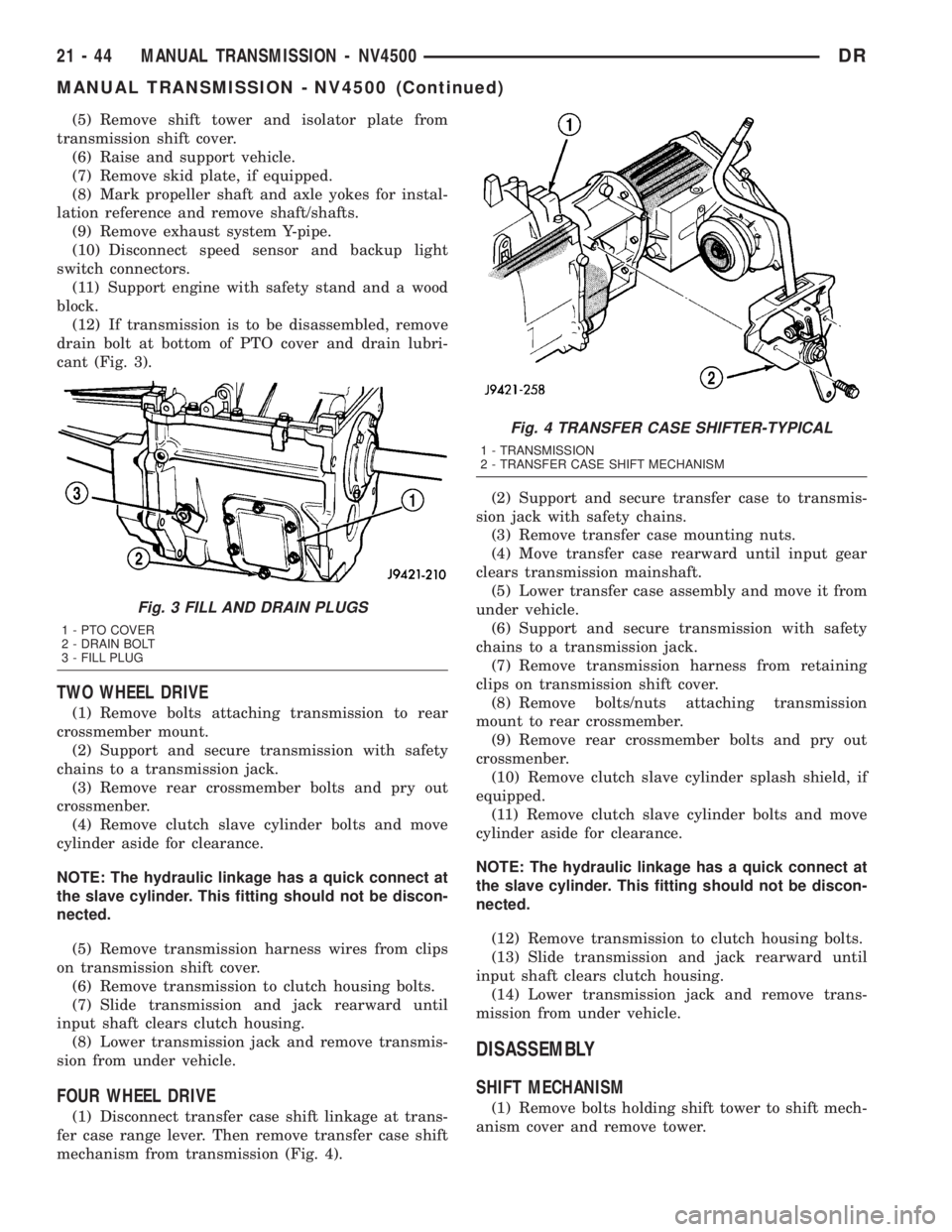
(5) Remove shift tower and isolator plate from
transmission shift cover.
(6) Raise and support vehicle.
(7) Remove skid plate, if equipped.
(8) Mark propeller shaft and axle yokes for instal-
lation reference and remove shaft/shafts.
(9) Remove exhaust system Y-pipe.
(10) Disconnect speed sensor and backup light
switch connectors.
(11) Support engine with safety stand and a wood
block.
(12) If transmission is to be disassembled, remove
drain bolt at bottom of PTO cover and drain lubri-
cant (Fig. 3).
TWO WHEEL DRIVE
(1) Remove bolts attaching transmission to rear
crossmember mount.
(2) Support and secure transmission with safety
chains to a transmission jack.
(3) Remove rear crossmember bolts and pry out
crossmenber.
(4) Remove clutch slave cylinder bolts and move
cylinder aside for clearance.
NOTE: The hydraulic linkage has a quick connect at
the slave cylinder. This fitting should not be discon-
nected.
(5) Remove transmission harness wires from clips
on transmission shift cover.
(6) Remove transmission to clutch housing bolts.
(7) Slide transmission and jack rearward until
input shaft clears clutch housing.
(8) Lower transmission jack and remove transmis-
sion from under vehicle.
FOUR WHEEL DRIVE
(1) Disconnect transfer case shift linkage at trans-
fer case range lever. Then remove transfer case shift
mechanism from transmission (Fig. 4).(2) Support and secure transfer case to transmis-
sion jack with safety chains.
(3) Remove transfer case mounting nuts.
(4) Move transfer case rearward until input gear
clears transmission mainshaft.
(5) Lower transfer case assembly and move it from
under vehicle.
(6) Support and secure transmission with safety
chains to a transmission jack.
(7) Remove transmission harness from retaining
clips on transmission shift cover.
(8) Remove bolts/nuts attaching transmission
mount to rear crossmember.
(9) Remove rear crossmember bolts and pry out
crossmenber.
(10) Remove clutch slave cylinder splash shield, if
equipped.
(11) Remove clutch slave cylinder bolts and move
cylinder aside for clearance.
NOTE: The hydraulic linkage has a quick connect at
the slave cylinder. This fitting should not be discon-
nected.
(12) Remove transmission to clutch housing bolts.
(13) Slide transmission and jack rearward until
input shaft clears clutch housing.
(14) Lower transmission jack and remove trans-
mission from under vehicle.
DISASSEMBLY
SHIFT MECHANISM
(1) Remove bolts holding shift tower to shift mech-
anism cover and remove tower.
Fig. 3 FILL AND DRAIN PLUGS
1 - PTO COVER
2 - DRAIN BOLT
3 - FILL PLUG
Fig. 4 TRANSFER CASE SHIFTER-TYPICAL
1 - TRANSMISSION
2 - TRANSFER CASE SHIFT MECHANISM
21 - 44 MANUAL TRANSMISSION - NV4500DR
MANUAL TRANSMISSION - NV4500 (Continued)
Page 1884 of 2895
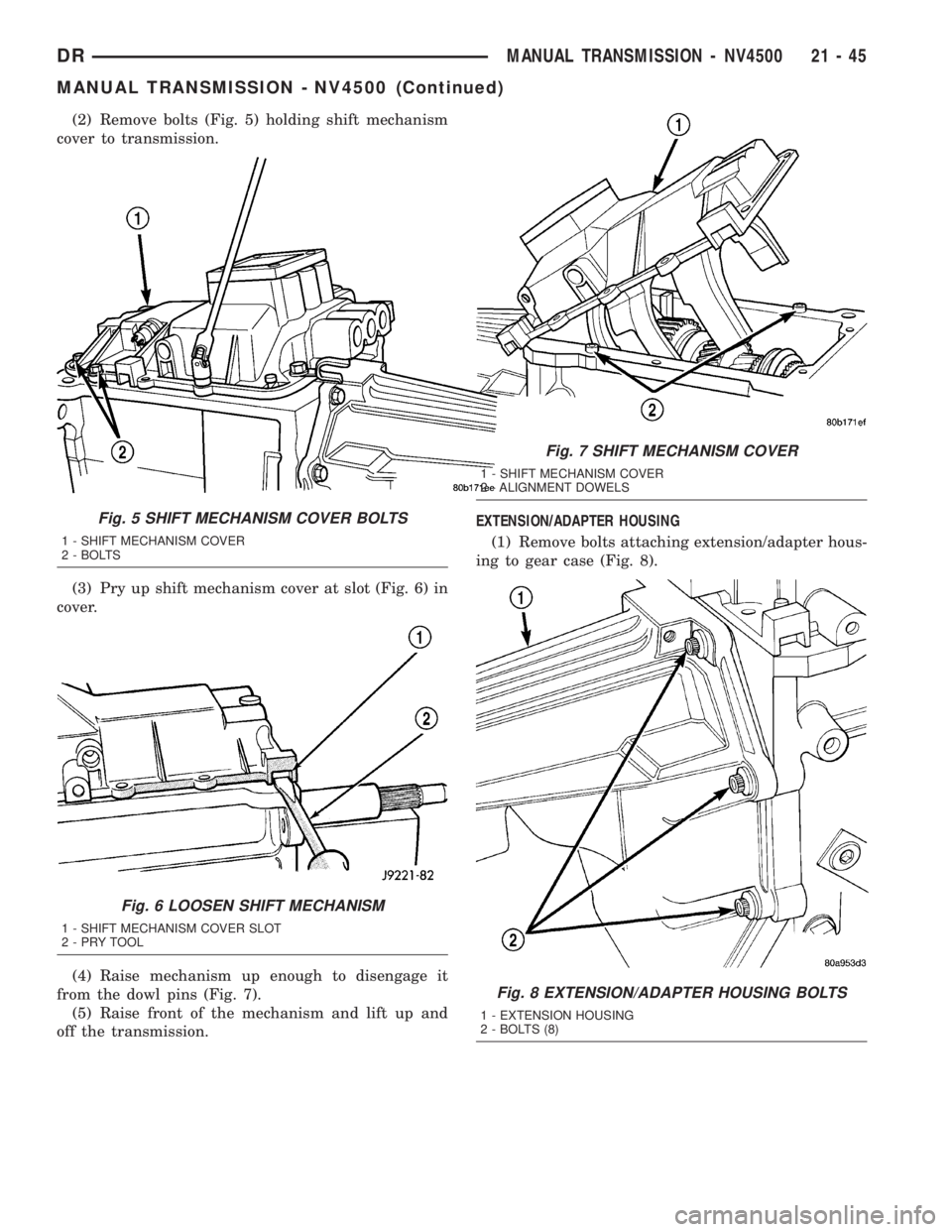
(2) Remove bolts (Fig. 5) holding shift mechanism
cover to transmission.
(3) Pry up shift mechanism cover at slot (Fig. 6) in
cover.
(4) Raise mechanism up enough to disengage it
from the dowl pins (Fig. 7).
(5) Raise front of the mechanism and lift up and
off the transmission.EXTENSION/ADAPTER HOUSING
(1) Remove bolts attaching extension/adapter hous-
ing to gear case (Fig. 8).
Fig. 5 SHIFT MECHANISM COVER BOLTS
1 - SHIFT MECHANISM COVER
2 - BOLTS
Fig. 6 LOOSEN SHIFT MECHANISM
1 - SHIFT MECHANISM COVER SLOT
2-PRYTOOL
Fig. 7 SHIFT MECHANISM COVER
1 - SHIFT MECHANISM COVER
2 - ALIGNMENT DOWELS
Fig. 8 EXTENSION/ADAPTER HOUSING BOLTS
1 - EXTENSION HOUSING
2 - BOLTS (8)
DRMANUAL TRANSMISSION - NV4500 21 - 45
MANUAL TRANSMISSION - NV4500 (Continued)
Page 1885 of 2895
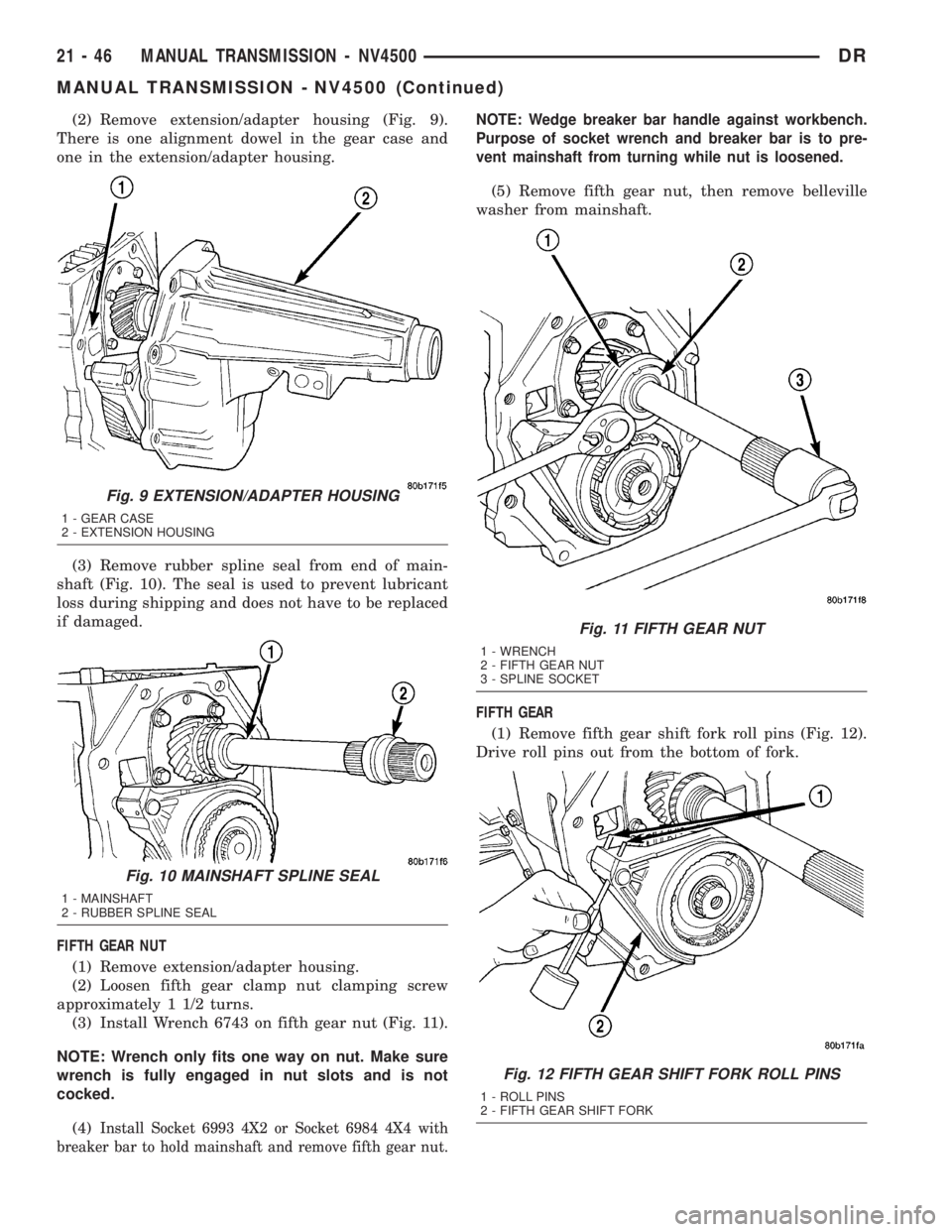
(2) Remove extension/adapter housing (Fig. 9).
There is one alignment dowel in the gear case and
one in the extension/adapter housing.
(3) Remove rubber spline seal from end of main-
shaft (Fig. 10). The seal is used to prevent lubricant
loss during shipping and does not have to be replaced
if damaged.
FIFTH GEAR NUT
(1) Remove extension/adapter housing.
(2) Loosen fifth gear clamp nut clamping screw
approximately 1 1/2 turns.
(3) Install Wrench 6743 on fifth gear nut (Fig. 11).
NOTE: Wrench only fits one way on nut. Make sure
wrench is fully engaged in nut slots and is not
cocked.
(4)
Install Socket 6993 4X2 or Socket 6984 4X4 with
breaker bar to hold mainshaft and remove fifth gear nut.
NOTE: Wedge breaker bar handle against workbench.
Purpose of socket wrench and breaker bar is to pre-
vent mainshaft from turning while nut is loosened.
(5) Remove fifth gear nut, then remove belleville
washer from mainshaft.
FIFTH GEAR
(1) Remove fifth gear shift fork roll pins (Fig. 12).
Drive roll pins out from the bottom of fork.
Fig. 9 EXTENSION/ADAPTER HOUSING
1 - GEAR CASE
2 - EXTENSION HOUSING
Fig. 10 MAINSHAFT SPLINE SEAL
1 - MAINSHAFT
2 - RUBBER SPLINE SEAL
Fig. 11 FIFTH GEAR NUT
1 - WRENCH
2 - FIFTH GEAR NUT
3 - SPLINE SOCKET
Fig. 12 FIFTH GEAR SHIFT FORK ROLL PINS
1 - ROLL PINS
2 - FIFTH GEAR SHIFT FORK
21 - 46 MANUAL TRANSMISSION - NV4500DR
MANUAL TRANSMISSION - NV4500 (Continued)
Page 1886 of 2895
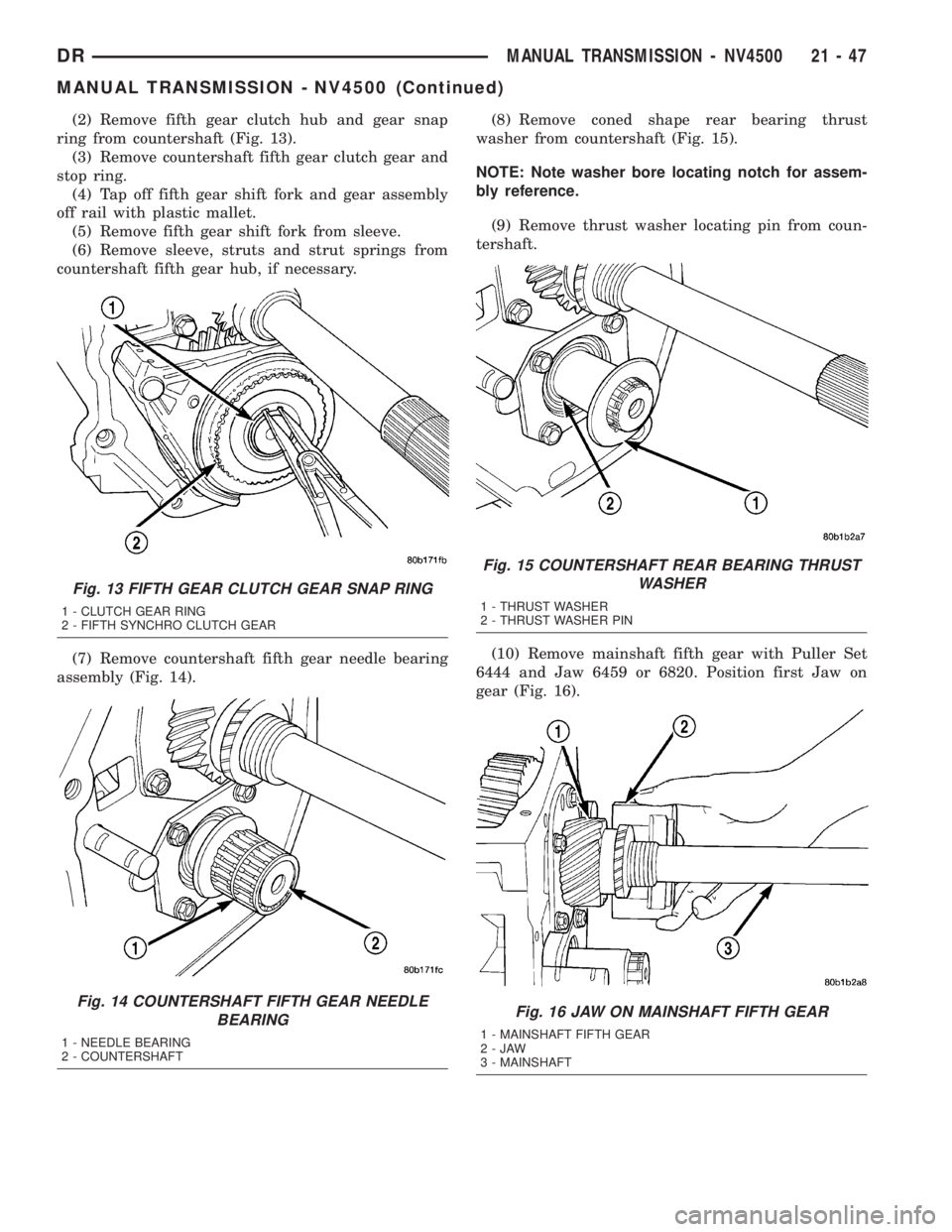
(2) Remove fifth gear clutch hub and gear snap
ring from countershaft (Fig. 13).
(3) Remove countershaft fifth gear clutch gear and
stop ring.
(4) Tap off fifth gear shift fork and gear assembly
off rail with plastic mallet.
(5) Remove fifth gear shift fork from sleeve.
(6) Remove sleeve, struts and strut springs from
countershaft fifth gear hub, if necessary.
(7) Remove countershaft fifth gear needle bearing
assembly (Fig. 14).(8) Remove coned shape rear bearing thrust
washer from countershaft (Fig. 15).
NOTE: Note washer bore locating notch for assem-
bly reference.
(9) Remove thrust washer locating pin from coun-
tershaft.
(10) Remove mainshaft fifth gear with Puller Set
6444 and Jaw 6459 or 6820. Position first Jaw on
gear (Fig. 16).
Fig. 13 FIFTH GEAR CLUTCH GEAR SNAP RING
1 - CLUTCH GEAR RING
2 - FIFTH SYNCHRO CLUTCH GEAR
Fig. 14 COUNTERSHAFT FIFTH GEAR NEEDLE
BEARING
1 - NEEDLE BEARING
2 - COUNTERSHAFT
Fig. 15 COUNTERSHAFT REAR BEARING THRUST
WASHER
1 - THRUST WASHER
2 - THRUST WASHER PIN
Fig. 16 JAW ON MAINSHAFT FIFTH GEAR
1 - MAINSHAFT FIFTH GEAR
2-JAW
3 - MAINSHAFT
DRMANUAL TRANSMISSION - NV4500 21 - 47
MANUAL TRANSMISSION - NV4500 (Continued)
Page 1887 of 2895
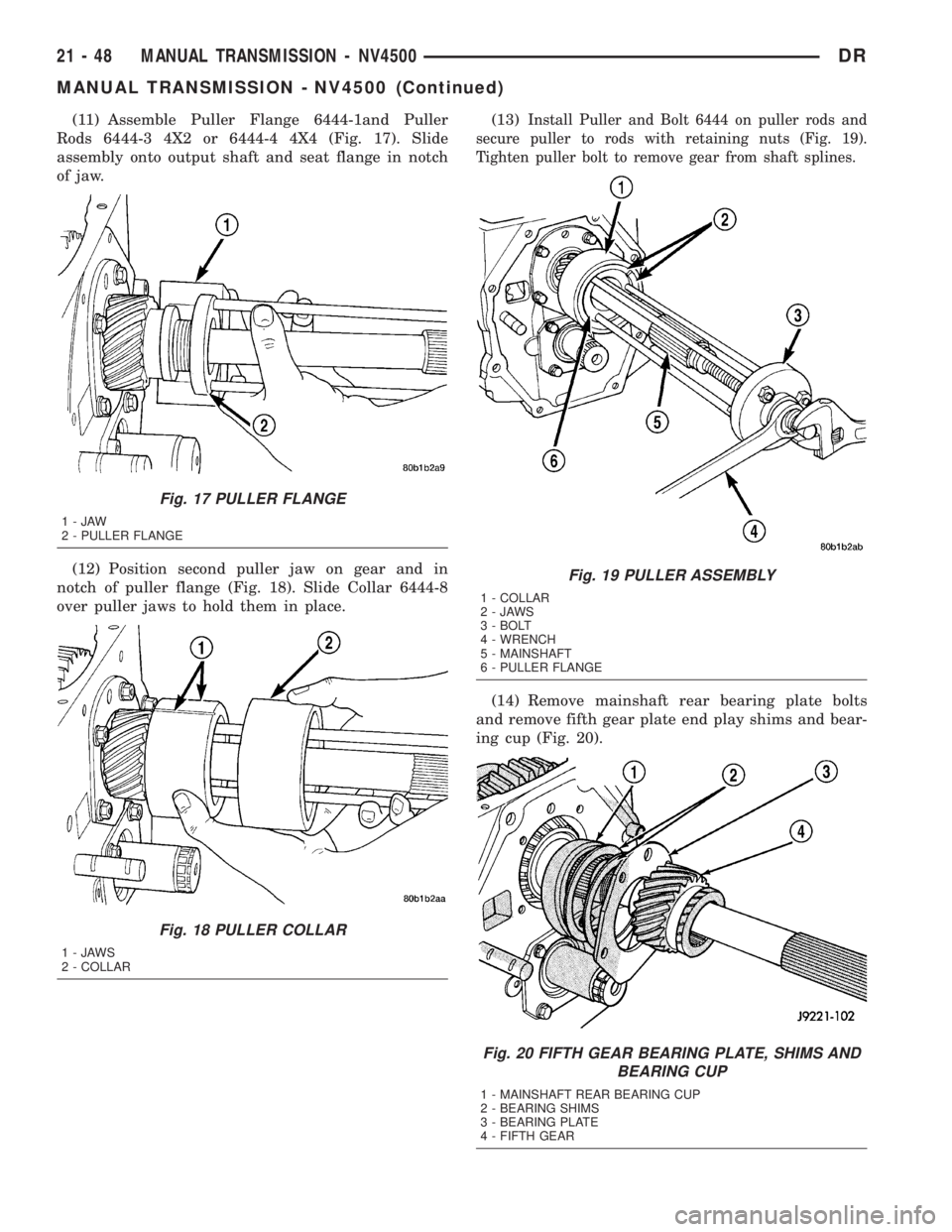
(11) Assemble Puller Flange 6444-1and Puller
Rods 6444-3 4X2 or 6444-4 4X4 (Fig. 17). Slide
assembly onto output shaft and seat flange in notch
of jaw.
(12) Position second puller jaw on gear and in
notch of puller flange (Fig. 18). Slide Collar 6444-8
over puller jaws to hold them in place.(13)Install Puller and Bolt 6444 on puller rods and
secure puller to rods with retaining nuts (Fig. 19).
Tighten puller bolt to remove gear from shaft splines.
(14) Remove mainshaft rear bearing plate bolts
and remove fifth gear plate end play shims and bear-
ing cup (Fig. 20).
Fig. 17 PULLER FLANGE
1-JAW
2 - PULLER FLANGE
Fig. 18 PULLER COLLAR
1-JAWS
2 - COLLAR
Fig. 19 PULLER ASSEMBLY
1 - COLLAR
2-JAWS
3 - BOLT
4 - WRENCH
5 - MAINSHAFT
6 - PULLER FLANGE
Fig. 20 FIFTH GEAR BEARING PLATE, SHIMS AND
BEARING CUP
1 - MAINSHAFT REAR BEARING CUP
2 - BEARING SHIMS
3 - BEARING PLATE
4 - FIFTH GEAR
21 - 48 MANUAL TRANSMISSION - NV4500DR
MANUAL TRANSMISSION - NV4500 (Continued)
Page 1888 of 2895
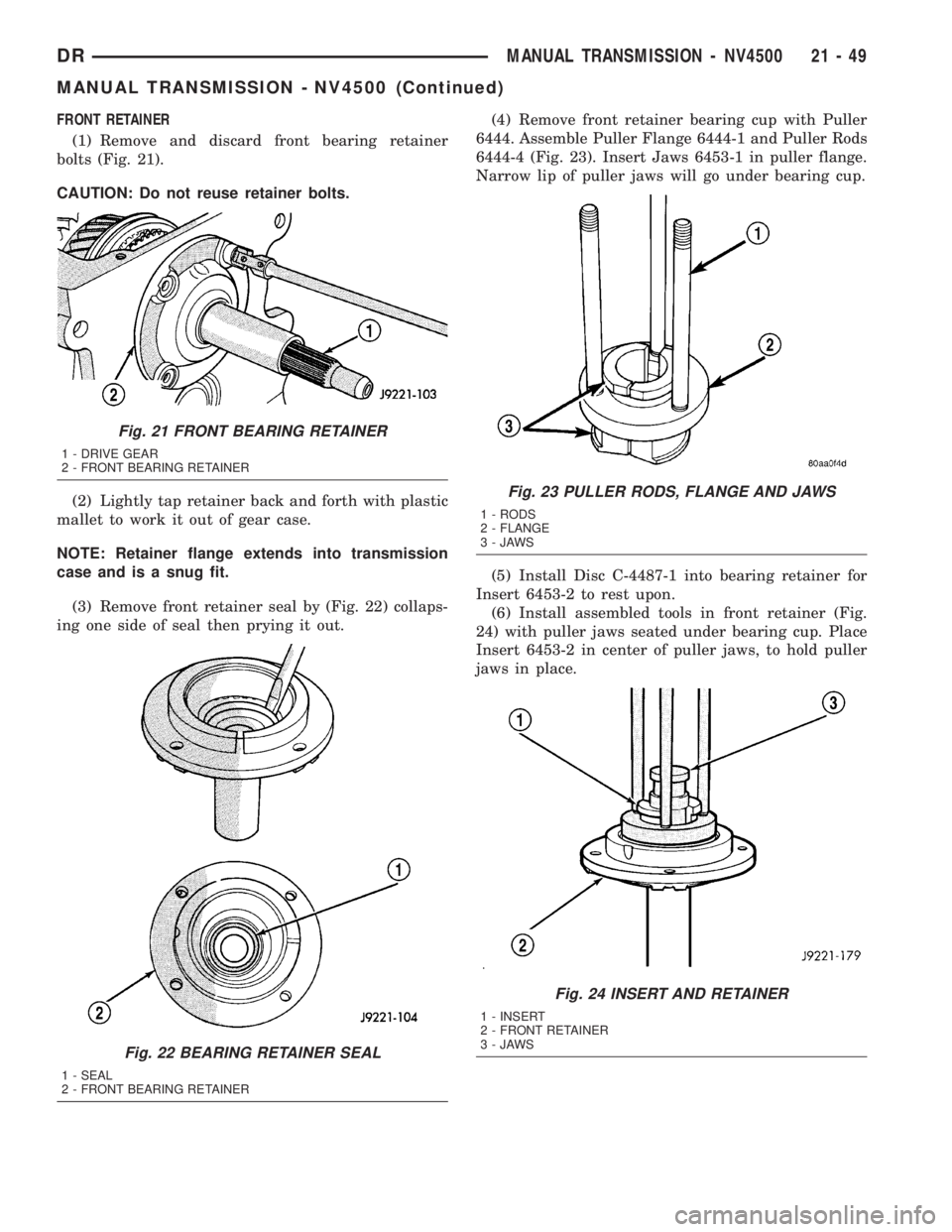
FRONT RETAINER
(1) Remove and discard front bearing retainer
bolts (Fig. 21).
CAUTION: Do not reuse retainer bolts.
(2) Lightly tap retainer back and forth with plastic
mallet to work it out of gear case.
NOTE: Retainer flange extends into transmission
case and is a snug fit.
(3) Remove front retainer seal by (Fig. 22) collaps-
ing one side of seal then prying it out.(4) Remove front retainer bearing cup with Puller
6444. Assemble Puller Flange 6444-1 and Puller Rods
6444-4 (Fig. 23). Insert Jaws 6453-1 in puller flange.
Narrow lip of puller jaws will go under bearing cup.
(5) Install Disc C-4487-1 into bearing retainer for
Insert 6453-2 to rest upon.
(6) Install assembled tools in front retainer (Fig.
24) with puller jaws seated under bearing cup. Place
Insert 6453-2 in center of puller jaws, to hold puller
jaws in place.
Fig. 21 FRONT BEARING RETAINER
1 - DRIVE GEAR
2 - FRONT BEARING RETAINER
Fig. 22 BEARING RETAINER SEAL
1 - SEAL
2 - FRONT BEARING RETAINER
Fig. 23 PULLER RODS, FLANGE AND JAWS
1 - RODS
2 - FLANGE
3-JAWS
Fig. 24 INSERT AND RETAINER
1 - INSERT
2 - FRONT RETAINER
3-JAWS
DRMANUAL TRANSMISSION - NV4500 21 - 49
MANUAL TRANSMISSION - NV4500 (Continued)
Page 1889 of 2895
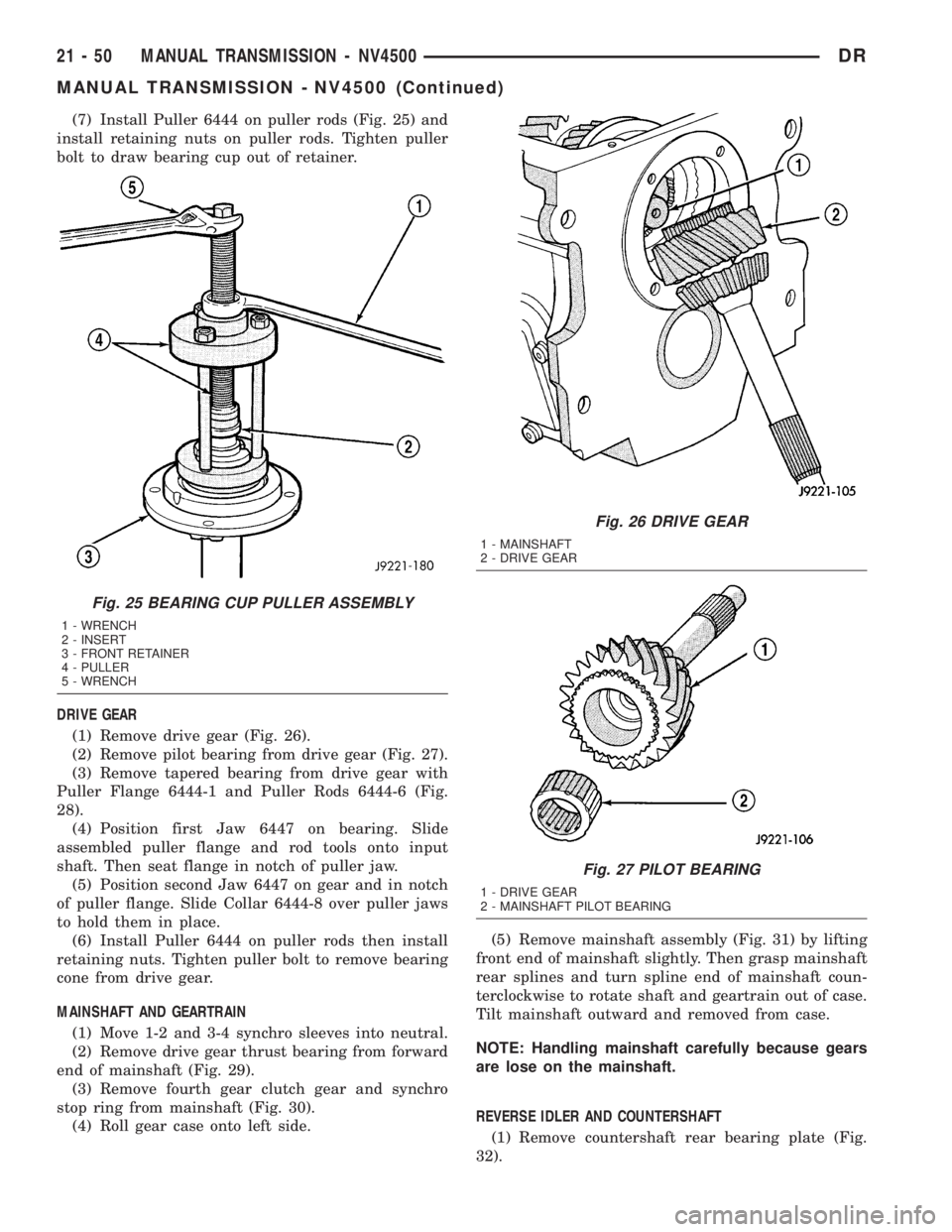
(7) Install Puller 6444 on puller rods (Fig. 25) and
install retaining nuts on puller rods. Tighten puller
bolt to draw bearing cup out of retainer.
DRIVE GEAR
(1) Remove drive gear (Fig. 26).
(2) Remove pilot bearing from drive gear (Fig. 27).
(3) Remove tapered bearing from drive gear with
Puller Flange 6444-1 and Puller Rods 6444-6 (Fig.
28).
(4) Position first Jaw 6447 on bearing. Slide
assembled puller flange and rod tools onto input
shaft. Then seat flange in notch of puller jaw.
(5) Position second Jaw 6447 on gear and in notch
of puller flange. Slide Collar 6444-8 over puller jaws
to hold them in place.
(6) Install Puller 6444 on puller rods then install
retaining nuts. Tighten puller bolt to remove bearing
cone from drive gear.
MAINSHAFT AND GEARTRAIN
(1) Move 1-2 and 3-4 synchro sleeves into neutral.
(2) Remove drive gear thrust bearing from forward
end of mainshaft (Fig. 29).
(3) Remove fourth gear clutch gear and synchro
stop ring from mainshaft (Fig. 30).
(4) Roll gear case onto left side.(5) Remove mainshaft assembly (Fig. 31) by lifting
front end of mainshaft slightly. Then grasp mainshaft
rear splines and turn spline end of mainshaft coun-
terclockwise to rotate shaft and geartrain out of case.
Tilt mainshaft outward and removed from case.
NOTE: Handling mainshaft carefully because gears
are lose on the mainshaft.
REVERSE IDLER AND COUNTERSHAFT
(1) Remove countershaft rear bearing plate (Fig.
32).
Fig. 25 BEARING CUP PULLER ASSEMBLY
1 - WRENCH
2 - INSERT
3 - FRONT RETAINER
4 - PULLER
5 - WRENCH
Fig. 26 DRIVE GEAR
1 - MAINSHAFT
2 - DRIVE GEAR
Fig. 27 PILOT BEARING
1 - DRIVE GEAR
2 - MAINSHAFT PILOT BEARING
21 - 50 MANUAL TRANSMISSION - NV4500DR
MANUAL TRANSMISSION - NV4500 (Continued)
Page 1890 of 2895
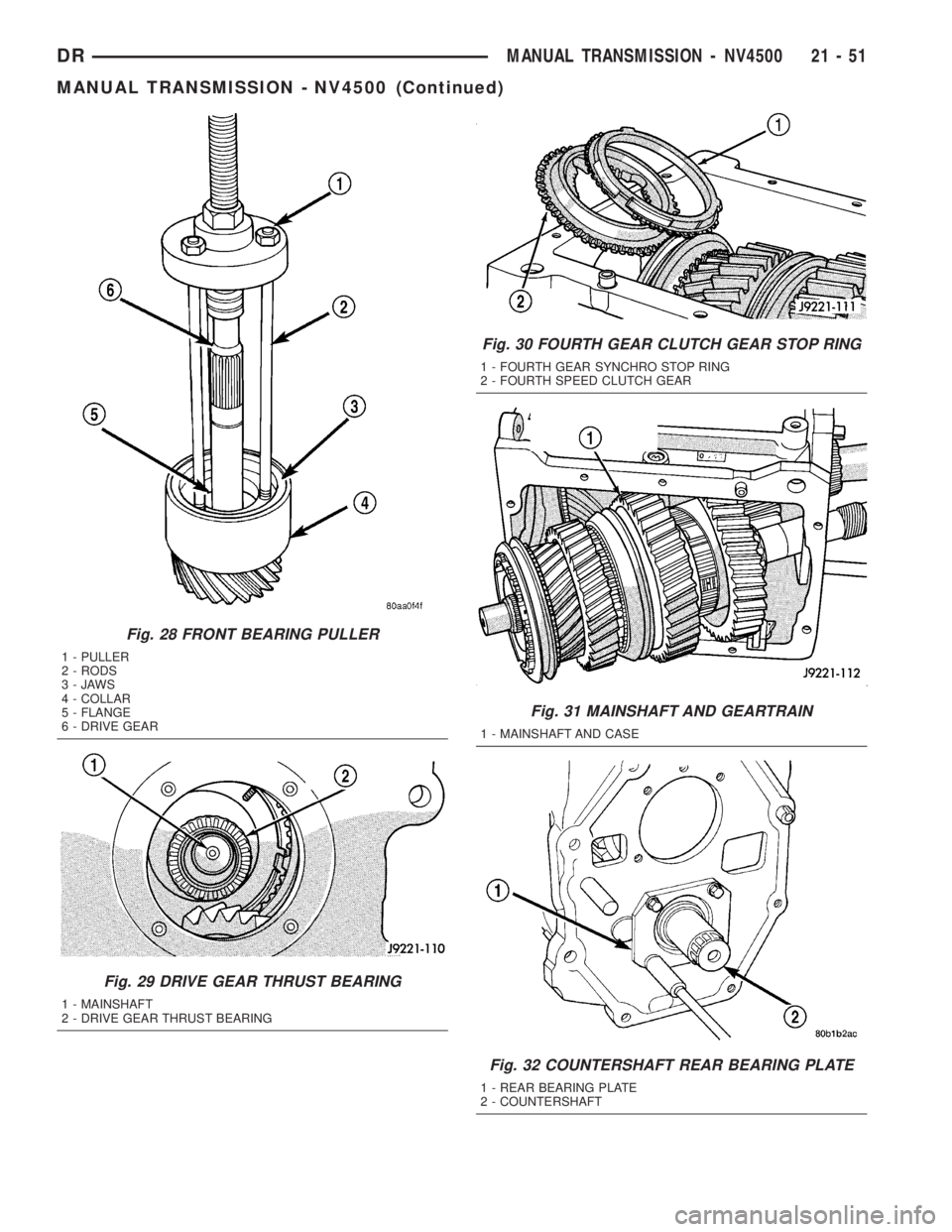
Fig. 28 FRONT BEARING PULLER
1 - PULLER
2 - RODS
3-JAWS
4 - COLLAR
5 - FLANGE
6 - DRIVE GEAR
Fig. 29 DRIVE GEAR THRUST BEARING
1 - MAINSHAFT
2 - DRIVE GEAR THRUST BEARING
Fig. 30 FOURTH GEAR CLUTCH GEAR STOP RING
1 - FOURTH GEAR SYNCHRO STOP RING
2 - FOURTH SPEED CLUTCH GEAR
Fig. 31 MAINSHAFT AND GEARTRAIN
1 - MAINSHAFT AND CASE
Fig. 32 COUNTERSHAFT REAR BEARING PLATE
1 - REAR BEARING PLATE
2 - COUNTERSHAFT
DRMANUAL TRANSMISSION - NV4500 21 - 51
MANUAL TRANSMISSION - NV4500 (Continued)